The October unemployment report is a pleasant surprise in comparison to recent months. Less people were dropped out of the labor force for the month, a welcome change. The labor participation rate though did not change from the October 1977 record lows. The official unemployment rate did tick down a tenth of a percentage point to 5.0%. Overall, this month's report is a surprise on the positive side.
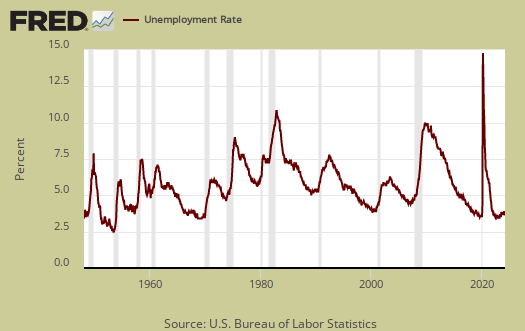
This article overviews and graphs the statistics from the Employment report Household Survey also known as CPS, or current population survey. The CPS survey tells us about people employed, not employed, looking for work and not counted at all. The household survey has large swings on a monthly basis as well as a large margin of sampling error. This part of the employment report is not about actual jobs gained but people and their labor status.
Those employed increased by 320,000 this month and stands at 149,120,000. From a year ago, the ranks of the employed has increased by 1.86 million, but that annual gain is much less than it was a month ago.

Those unemployed decreased by -7,000 to stand at 7,908,000. From a year ago the unemployed has decreased by -1.075 million. Below is the month change in unemployed and as we can see, this number typically has wild swings from month to month.
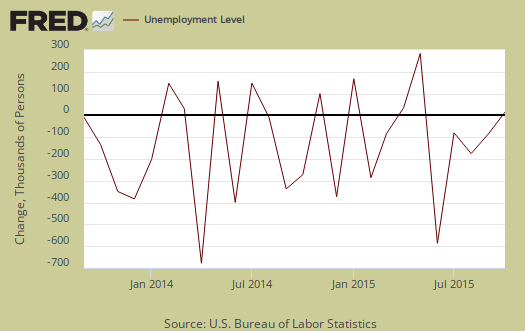
Those not in the labor force actually decrease this month by -97,000 to 94.51 million. The below graph is the monthly change of the not in the labor force ranks. Those not in the labor force has increased by 2,09,000 in the past year. While this month the deluge seems to have abated, those not in the labor force have grown more than those employed in the last year.

The labor participation rate remained the same, 62.4%, and this is a 38 year low.

Below is a graph of the labor participation rate for those between the ages of 25 to 54. The rate is 80.7%, which is a 0.1 percentage point change from last month. Using the prime working years participation rate proves the record lows cannot be explained away by retirement and higher education pursuits.
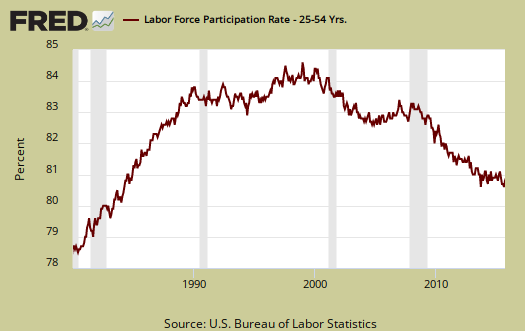
The civilian labor force, which consists of the employed and the officially unemployed, increased by 313 thousand this month, negating last month's decline. The civilian labor force has grown by 785,000 over the past year. This annual growth rate is really low. New workers enter the labor force every day from increased population inside the United States and immigration, both legal and illegal. The small annual figure also implies people are dropping out of the labor force. Notice how those not in the labor force has grown much bigger than the civilian labor force.
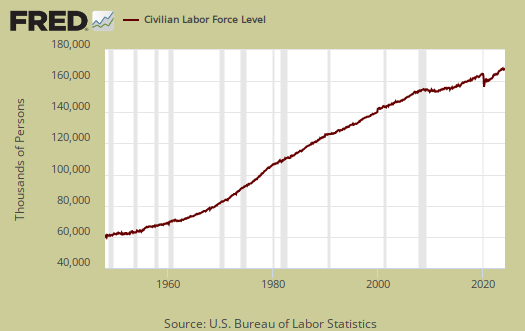
Those not in the labor force now grows faster than the population which has the potential to work. Below is a graph of those not in the labor force, (maroon, scale on the left), against the noninstitutional civilian population (blue, scale on the right). Notice how those not in the labor force crosses the noninstitutional civilian population in growth and the accelerated growth started happening right in 2008. The increase cannot be explained by retiring baby boomers alone and notice the recent uptick.

Below is a graph of the civilian labor force, or the official employed plus unemployed, in maroon, scale on left, against those not in the labor force, in blue, scale on right. See how those not in the labor force as a trend exceeded those considered employed and unemployed starting around mid 2009. Starting in 2014 it has reverted back, yet look at how is it reverted once again! The never ending growing segment of the population that is considered neither employed or unemployed, was above the trend line of those who would be naturally dropping out, such as the retired and those in school. This shows those not in the labor force was growing much faster than those obtaining jobs and being counted as looking for work. Those not in the labor force does include retirees and the size of the population 65 and older has grown.
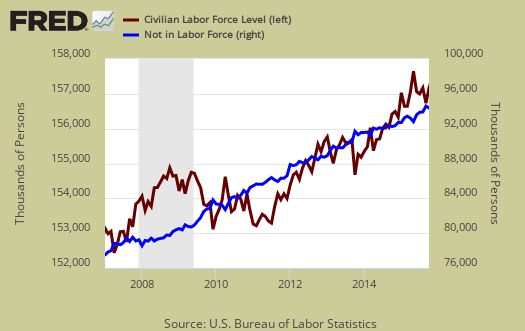
Those considered employed as a ratio to the total Civilian noninstitutional population now stands at 59.3%, a 0.1 percentage point change from last month. The relationship between the employment-population ratio and the labor participation rate (LPR) is: employment-population ratio = LPR * (1 - unemployment rate).
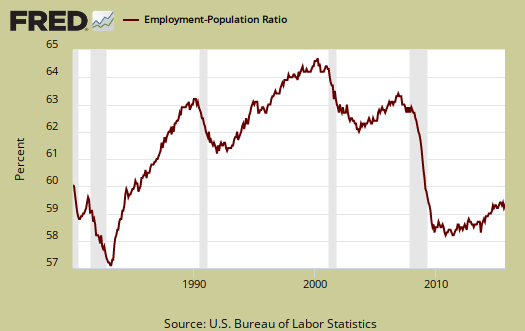
Those forced into part-time work due to the economy dropped for the second month in a row and this month by -269 thousand. . Those forced into part time work for economic reasons stands at 5,767,000 people. The annual decrease is now -1.245 million, this is really significant and a very good sign.
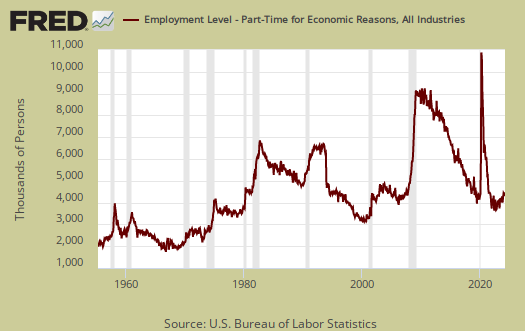
There are two categories of those forced into part-time jobs due to economic circumstances. Those who could only get part-time jobs and those already working who got their hours cut due to businesses not having enough work for them. The number of people who could only get part-time work increased by 48,000 as shown below.

People can also work part-time hours due to slack business demand. People who got their hours cut due to slack working conditions decreased by -290,000 and stands at 3,279,000. Below is a graph of forced into part-time work because they got their hours cut, as a percentage of the total employed. This is a recession economic indicator and this figure just is still elevated, yet this figure has now plunged by 936 thousand from last year mostly due to the last two months over half a million decline.
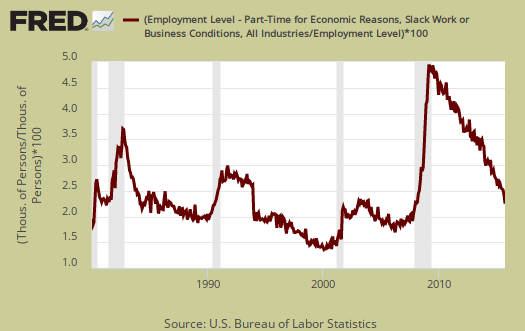
Part-time workers who are voluntarily working part-time jobs increased by 198,000 to stand at 20,169,000.
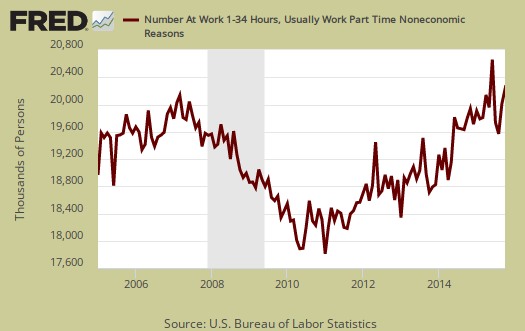
U-6 now just broke double digits and stands at 9.8% a -0.2 percentage point decrease. U-6 is a broader measure of unemployment and includes the official unemployed, people working part-time hours because that's all they can get and a subgroup not counted in the labor force but are available for work and looked in the last 12 months. The U-6 rate still leaves out some people wanting a job who are not considered part of the labor force, so while it is called an alternative rate, but it still ignores many who should be counted as unemployed.

The newly unemployed decreased by -37.000 to 2,326,000. Below is a graph of those unemployed for less than five weeks.

The long term unemployed, or those unemployed for 27 weeks and over, increased by 38 thousand to 2,142,000 people. From a year ago the long term unemployed ranks has declined by -762,000. This decline without a corresponding bump up in employed can imply many long term unemployed are simply dropped from the labor force.

Within the CPS survey is how many people who are considered not in the labor force who report they want a job now. It is a direct survey question. The Census asks people who are not being counted in the unemployment statistics and official unemployment rate if they want a job. The number who answer yes currently stands at 6,052,000, and increased by 97 thousand from last month. Those who are not counted yet report they want a job includes the discouraged workers and marginally attached and is seasonally adjusted. This figure has decreased by 493 thousand from a year ago.
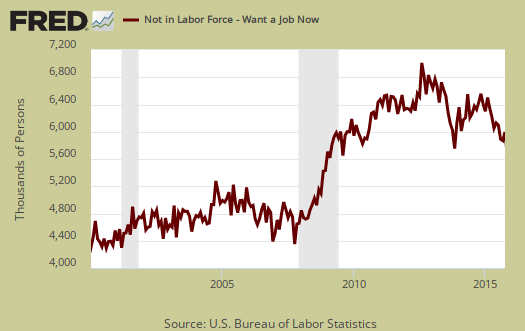
The average length of unemployment is 28 weeks and a year ago was 32.9 weeks. This is a 1.7 week increase from last month The average time to be unemployed is out of line with the median due to the long term unemployed.
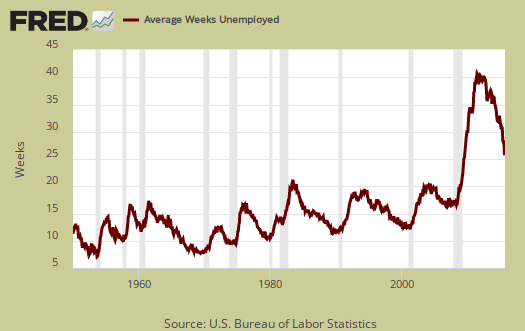
The median time one is unemployed, which means 50% of people have gotten a job in this amount of time is 11.2 weeks and decreased 0.2 weeks from last month. A year ago the median time to be unemployed was 13.5 weeks.
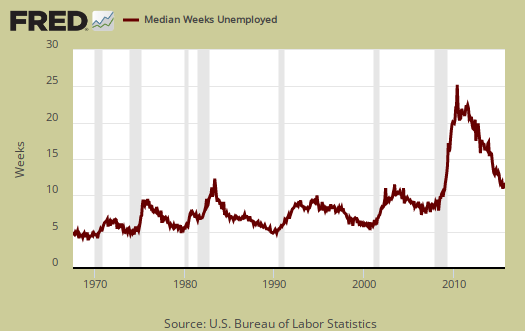
This month's CPS report is a stop the hemorrhage of a shrinking labor force and labor participation rates. The decline in slack working conditions is a very positive sign. This report should alleviate worry, yet being confident America's workforce is on the mend is a mistake. The U.S. manufacturing sector just continues to get hammered and so the quality of new jobs is in question. Here are our past overviews CPS unemployment statistics, only graphs revised.

Just curious ...
Has anybody ever taken that CPS survey? Or know of someone that has? Or knows somebody who knows somebody? I've been a round for a few decades, and was never called about this survey. And in all those years, I don't know of a single person that has ever taken that survey either. Odd, isn't it?